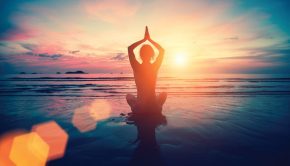Qi Whiz, Qigong Steps Up Vitality and Serenity
A proven practice for supporting health and self-healing, qigong has been used in China for millennia to maintain and improve physical, mental and emotional well-being.
“Qi” (pronounced chee) refers to the life force or vital energy present in all things throughout the universe while “gong” means dedicated effort or steady practice of a skill. Qigong is the art of working intensely with this energy, cultivating life force.
Acupuncture physician and qigong instructor Walter Hayley, in Bonita Springs, Florida, became passionate about qigong while working as a stockbroker in need of stress relief. He compares qigong’s movement of energy in the body to water running through a hose: “Qi is concentrated in channels throughout the body. Think of the qi as water and those channels as a garden hose branching out to every aspect of the individual. Stress, whether physical or emotional, can kink the hose. Qigong helps get the kinks out,” he explains. “It relaxes the body, letting energy flow more efficiently, allowing the body to heal itself.”
Qigong styles vary, but Hayley remarks that most involve slow movement, focused awareness and special breathing techniques. Many describe the practice as a moving meditation.
Qigong teacher Judith Forsyth, in Mobile, Alabama, says, “It’s often described as the mother of tai chi. When the quiet, internal energy art of qigong mixed with the powerful external martial arts, it developed into tai chi.” She emphasizes that the focus of qigong is less on its physical mechanics and more on understanding how the vital force moves through the body and can be used to enhance health and longevity.
Inside the body, there’s an integrated network of subtle energy centers that international Qigong Master Robert Peng believes are connected to the capacity for genuine happiness. The goal is to awaken and pack these centers with qi. “By repeating slow, gentle movements over and over, you can develop the body’s capacity to draw qi from the universe. It can be stored in these centers and later channeled back through the body to empower your daily activities,” explains Peng, author of The Master Key: The Qigong Secret for Vitality, Love, and Wisdom.
He focuses on three of the body’s big energy portals: the “third eye”, located between the eyebrows; the “heart center”, at the center of the chest on the sternum and the “sea of qi”, just below the navel. The idea is that when energy is accessed in these three centers, specific spiritual qualities are accessed: wisdom, love and vitality (respectively). Harmonizing all three is ideal.
By adding qigong to their daily routines, children learn to channel energy and enhance concentration; office workers reduce stress; seniors enhance balance and quality of life; and caregivers and midwives advance abilities to help others. ~ The National Qigong Association
Peng advises that when these essential elements are woven together in balance, dynamic happiness is possible. “You begin to project more wisdom, love, vitality, inspiration and peacefulness. Conversations flow more smoothly. Your life becomes more productive, meaningful and serene,” he says. “Whatever the challenges encountered, you’ll be better equipped to deal with them, while remaining inwardly content.”
Forsyth was first guided to qigong when the prescribed rest, drugs, exercise and physical therapy following an accident left her with lingering neck and back problems. She recalls, “After eight weeks of practice, I experienced significant physical improvement, not only where I had considerable pain, but in my overall energy level, ability to sleep and the condition of my skin and hair. The peace and harmonizing meditation benefits of qigong were also affecting me positively in other ways. I became less worried, less of a perfectionist, less stressed out and began to experience more joyfulness.”
While all styles benefit overall health, specific qigong exercises may be prescribed for specialized needs, from athletic conditioning to management of chronic conditions such as arthritis, hypertension or cancer. The gentle movements can be performed by almost anyone at any age and ability level, even those confined to a chair or bed. “Qigong speaks to the body and the body then addresses the condition,” Hayley remarks.
The experts advise that qigong is best practiced every day, even if for just five minutes. “A group class offers a synergy that a home practice lacks, but the more important practice is at home,” observes Hayley. Some personal instruction is ideal so the practitioner receives feedback, but books and videos make qigong accessible to everyone, everywhere.
Hayley reminds newbies, “Just be patient. If one form doesn’t suit you, remember there are thousands of different forms to try.”
Peng’s advice to beginners is, “Be happy! Think of the exercise as lighthearted play and remember to smile as you move.”
Meredith Montgomery is the publisher of Natural Awakenings Mobile/Baldwin, AL (HealthyLivingHealthyPlanet.com).
<












